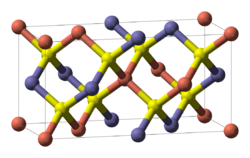Top Qs
Timeline
Chat
Perspective
Copper indium gallium selenide
Chemical compound From Wikipedia, the free encyclopedia
Remove ads
Copper indium gallium (di)selenide (CIGS) is a I-III-VI2 semiconductor material composed of copper, indium, gallium, and selenium. The material is a solid solution of copper indium selenide (often abbreviated "CIS") and copper gallium selenide. It has a chemical formula of CuIn1−xGaxSe2, where the value of x can vary from 0 (pure copper indium selenide) to 1 (pure copper gallium selenide). CIGS is a tetrahedrally bonded semiconductor, with the chalcopyrite crystal structure, and a bandgap varying continuously with x from about 1.0 eV (for copper indium selenide) to about 1.7 eV (for copper gallium selenide).
Remove ads
Structure
CIGS is a tetrahedrally bonded semiconductor, with the chalcopyrite crystal structure. Upon heating it transforms to the zincblende form and the transition temperature decreases from 1045 °C for x = 0 to 805 °C for x = 1.[1]
Applications
It is best known as the material for CIGS solar cells a thin-film technology used in the photovoltaic industry.[2] In this role, CIGS has the advantage of being able to be deposited on flexible substrate materials, producing highly flexible, lightweight solar panels. Improvements in efficiency have made CIGS an established technology among alternative cell materials.
See also
References
Wikiwand - on
Seamless Wikipedia browsing. On steroids.
Remove ads

